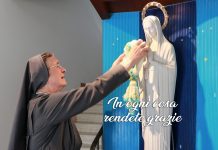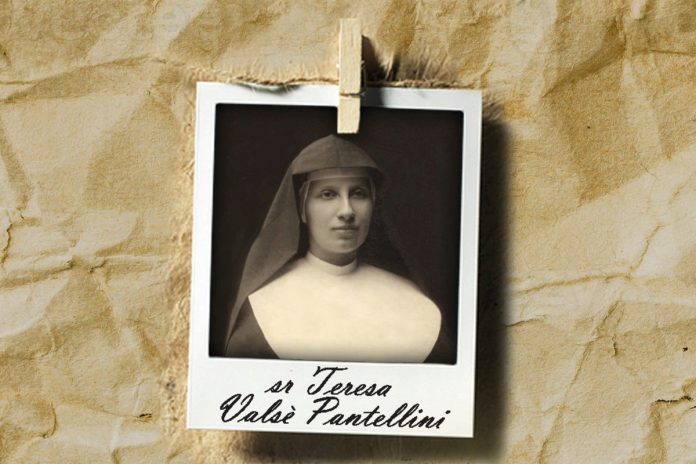Nizza Monferrato (Italy). On 3 September 2022, we celebrate the birth of the Venerable Sr. Teresa Valsè Pantellini, the youngest Daughter of Mary Help of Christians whose beatification and canonization process was begun (in 1926), on 12 July 1986, reached the declaration of venerability.
On the 150th anniversary of the foundation of the FMA Institute, Sr. Piera Cavaglià, Secretary Emeritus of the Institute and Animator of O. L. of Grace of Nizza Monferrato (AT), of the FMA Province of Mary Help of Christians (IPI), presents a characteristic trait of her spirituality:
To say love for the oratory is to recall the solidarity love for poor girls, the attentive care of Sr. Teresa Valsé for their integral promotion. Sometimes we think that, for a good oratory, optimal spaces, means, and opportunities are necessary. These are useful, but they do not compensate for the ardor of the da mihi animas that vibrates in the heart of an educator and a community.
From when she was a novice in Rome in the house called ‘Bosco Parrasio’ on the slopes of the Janiculum (1901-1902), although it was an uncomfortable, poor, and not very functional house, Sr. Teresa immediately dedicated herself to the oratory for the lively girls of Trastevere. There were about a hundred. There was no flat courtyard, but flower beds made up of steps between grass and ancient trees. Hence the name of Bosco Parrasio.
A General Councilor, Mother Eulalia Bosco, who went to visit that house said, “I have visited many Novitiates in Italy and abroad, but I did not find a novitiate more uncomfortable and poorer than the Novitiate of Bosco Parrasio.” Sr. Teresa’s brother noted that she was happy to be in a poor house because she “was happy to be poor”.
Sr. Teresa had the task of following the older ones and devoting herself to their religious formation through catechesis and commitment groups. In the Chronicle of the House, she herself noted:
“They were numerous, poor, uncultivated creatures, abandoned, without protection and defense… They filled the sacred Forest to the skies with their shouts of joy, their songs, their festive leaps, and also their neither little nor slight mischief. But that didn’t matter to us. Don Bosco had seen much more in Valdocco. His daughters were not upset about anything in order to do a little good to those souls who were so in need. What did the rest matter?”.
The Oratory was inside her; it flowed from her heart in love with Jesus and the poor, and this ardent love helped her to overcome every effort. The girls were drawn to her warm and kind ways and “flocked to her in celebration”.
As a true Salesian educator, Sr. Teresa participated in the games, took care of catechetical formation, prayer, and sacramental life. She was skilled in music, in the entertainments that she prepared with creativity and pleasant resourcefulness.
An example taken from one of her handwritten notebooks there is a theatrical text on the Oratory as a dialogue between two girls with very different approaches and ideas:
“One says: Good morning, Agnes, where are you going with that bouquet of flowers?
And the friend replies: I’m going to the Oratory. Today there is a big feast, you know; we will have a beautiful show in honor of Mary Help of Christians. Do you want to come with us?
Here is the response, which is well motivated. No indeed! I have already told you, my dear, that I cannot stand the sisters. I have modern ideas. Keep your bigotry to yourself.
And the other insists: If you came, you would immediately understand that you are deceiving yourself”.
This girl then shares her suffering, the bad friends she met, and eventually goes to the oratory, conquered by the strong convictions of Agnes who understood, welcomed and comforted her. The testimonies about Sr. Teresa attest to us that she “was the confidant and counselor of the Oratorians”. She believed in the educational value of the oratory, despite the difficulties.
The house and the oratory were very poor and several times it was considered to close them. She counted on Providence and was creatively committed to attracting girls to goodness and also to seeking benefactors, trusting very much in the presence of St. Joseph.
Even after her religious profession, made in Nizza on 3 August 1903, Sr. Teresa, although in poor health, returned for a period to Rome and continued to dedicate herself to the poor girls of Trastevere. Her dream was indeed to make them have fun, but above all, to form them as women, Christians engaged in work, in the journey of faith and in the witness of life.
For poor girls, the oratory was a meeting place, and above all a laboratory of humanity, formation, Salesian joy, and preparation for a new future.
Monthly Rosarye
To rediscover the figure of Sr. Teresa Valsè Pantellini and rely on her intercession, the Historical Archive of the O. L. of Grace house in Nizza Monferrato proposes praying the Rosary each month, enriched with an introduction by Sr. Piera Cavaglià.
The rosary will be prayed every 3rd of the month at 9:00 pm (Italian time) by the Church of the Sacred Heart, where Sr. Teresa is buried, and will be broadcast in live streaming on the YouTube Channel of the FMA-IPI Historical Archive.





















Grazie per questa bellissima possibilità di conoscere meglio sr Teresa